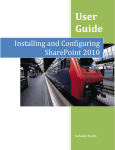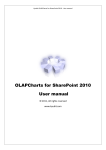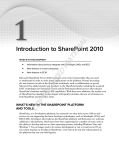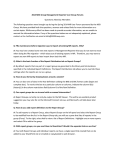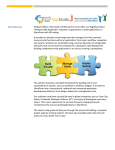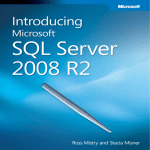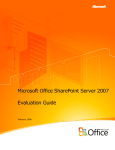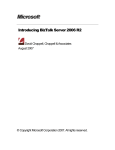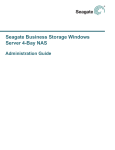Download Wiley MCTS Microsoft SharePoint 2010 Configuration Study Guide: Exam 70-667
Transcript
What’s New in Microsoft SharePoint 2010 Chapter 1 RI AL Microsoft Exam Objective Covered in This Chapter: Deploy new installations and upgrades CO PY RI GH TE D MA NN TE ÛÛ Installing and Configuring a SharePoint Environment If you picked up this book, it’s because you’re committed to using and administering Microsoft SharePoint Server in some capacity. Either you are a current Microsoft Office SharePoint Server 2007 (MOSS 2007) administrator who is anticipating upgrading to SharePoint Server 2010 or you are planning a first-time SharePoint deployment for your production environment. You may also be someone who has yet to experience SharePoint but is looking to expand your skill set. In any case, the information presented here will both prepare you for the 70-667 “TS: Microsoft SharePoint 2010, Configuring” certification exam and be invaluable in deploying and managing a SharePoint 2010 environment. This book is written with the student in mind, but if you belong to any of the groups just mentioned, you qualify as a student—someone in a position to learn something new, whether for the purpose of sitting an exam or to hone your administrative skills in the production SharePoint arena. This book has been created from the point of view of a person building a personal lab or sandbox environment, but the content is equally applicable to the SharePoint administrator invested in rolling out SharePoint Server 2010 to production in the enterprise. While subsequent chapters will address the specific information you’ll need to know about how to upgrade MOSS 2007 to SharePoint Server 2010 and to deploy a first-time installation, you need to first take some time to understand just how different SharePoint Server 2010 is from MOSS 2007. It’s not a matter of simply launching an upgrade executable and following a wizard. There’s a whole new world of hardware and software requirements to learn and understand. New Requirements Overview Before launching into the specifics of the certification exam domains, it’s important to take some time to get to know the basics of SharePoint Server 2010. Even if you’re familiar with MOSS 2007, Microsoft’s latest release of SharePoint has a lot of new features and contains perhaps a few surprises. In a nutshell, these are the new requirements for SharePoint Server 2010: NN NN NN SharePoint Server 2010 is a 64-bit only application. SharePoint Server 2010 will be able to run only on 64-bit Windows Server 2008 or 64-bit Windows Server 2008 R2. SharePoint Server 2010 will be able to use only 64-bit SQL Server 2008 or 64-bit SQL Server 2005 for database services. New Requirements Overview 3 There are a number of other specifics, but before you continue, you must have access to both the required Windows Server and SQL Server versions, as well as a 64-bit hardware platform. If you are using 32-bit hardware in either your production or testing environment, you will not be able to install or upgrade to SharePoint Server 2010. Also, earlier versions of Windows Server and SQL Server will not be adequate. At this point, you may be questioning the rationale of Microsoft in making decisions relative to a 64-bit platform. It’s important both to understand why 32-bit hardware and server environments are no longer supported and to learn about other changes and compatibility issues. If you currently administer MOSS 2007 in the enterprise, you likely already run 64-bit hardware and may even have upgraded to 64-bit Windows Server 2008 or Windows Server 2008 R2. If the advantages of running 64-bit aren’t apparent to you (and especially if you’re lamenting how moving from 32-bit is going to stretch your personal or professional budget), you’ll need to learn more about why Microsoft moved in this direction. To find out the basics of x86 64-bit architecture, visit http://en.wikipedia .org/wiki/64-bit and http://en.wikipedia.org/wiki/X86-64. The Advantages of 64-Bit Hardware Comparing 64-bit hardware to 32-bit hardware is a little like comparing a mid-range sedan to a high-end sports car. Each has its purpose and does well in the area it’s designed for, but the sports car will go a lot faster when asked. Bus architecture supports more and wider registers and improves overall application performance speeds by reducing the need to write persistent data to memory. The most memory a 32-bit system can support is 4 GB of RAM. A 64-bit system that is running a 64-bit edition of Windows Server can support up to 1024 GB of both physical and addressable memory. SharePoint is an application that’s designed to grow with a company’s needs. Its ability to use more memory means SharePoint can serve greater access and service requirements. 32-bit hardware supports up to 32 processors. That might seem like a lot, but in a truly demanding environment, particularly one where you anticipate needing to scale up based on business needs, the ability to expand to a maximum of 64 processors is a great advantage. The Advantages of 64-Bit Server and Database Platforms The aforementioned hardware advantages don’t just apply to SharePoint Server 2010 as an application but to the Windows Server 2008 and SQL Server platforms in terms of speed, security, and scalability. Even assuming a single physical server platform, Windows Server 2008 can take advantage of a lot more RAM and processing power than on a 32-bit machine, addressing up to 16 terabytes of virtual memory by using a flat addressing model. This gives SQL Server 4 Chapter 1 What’s New in Microsoft SharePoint 2010 n access to almost unlimited virtual memory, as well as physical memory. Database servers are extremely resource intensive, and any database administrator will immediately see the advantages. Although the set of features available in 64-bit Windows Server 2008 is not appreciably different from its 32-bit counterpart, there are some important security considerations. 64-bit Windows Server 2008 offers greater buffer overflow protection because the first parameters of a procedure call are passed in registers. Since the correct values have to be assigned in the registers and both addresses and variables have to be aligned on the stack, the data buffer is less likely to become congested and thus present a security concern. 64-bit processors made by AMD and Intel include hardware support for data execution prevention (DEP) to prevent any malicious executables from running, even in the unlikely event of a buffer overflow. Also, Microsoft Patch Guard prevents any kernel mode drivers in third-party applications from extending or replacing kernel services in Windows Server 2008. It’s intuitively obvious that more processing power and more physical and virtual memory support equals “better,” but in terms of scalability, having access to so much more memory than is supported on 32-bit platforms means that both Windows Server 2008 and SQL Server can load large amounts of working data entirely in memory. Users and administrators should notice no apparent performance lags as workload demands increase over time, even if the demands increase dramatically. This also results in decreasing the need for as many application servers, since larger loads can be handled by fewer servers. Considerations of 32-Bit and 64-Bit It’s certainly possible to install some 64-bit applications on a 32-bit platform, but you won’t see any of the advantages offered by the software. The software environment won’t have the necessary hardware to execute all of its potential, much like putting high-test fuel in a 1970s vintage Volkswagen beetle. Performance may be improved somewhat, but you really need to join elements together that provide the most advantage, which means running 64-bit applications on 64-bit hardware. 64-bit Windows Server 2008 does include the Windows on Windows 64-bit (WOW64) translation layer, which emulates a 32-bit operating system, so running a mixed 32-bit and 64-bit environment is possible. Although this may seem like an advantage if you need to run a legacy application on a 64-bit platform, in fact this doesn’t work with any of the 64-bit SharePoint applications and services. This means you cannot run a mixed 32-bit/64-bit environment, such as 64-bit SharePoint Server 2010 using 32-bit SQL Server 2005. The disadvantage from an up-front cost view is the requirement to upgrade all of your software and hardware platforms if you want to run SharePoint Server 2010. Although this may seem terribly unfair of Microsoft, its analysis of SharePoint test data and feedback from customers running MOSS 2007 has indicated that the performance and scalability advantages far outweigh the initial cost of upgrading. Whether you agree with this decision or not, the reality of 64-bit is here, and it’s here to stay. Requirements by Environment 5 Not all 64-bit processors are SharePoint Server 2010 friendly. The Intel Itanium 64-bit processor series uses a proprietary design that will not support any of the Microsoft SharePoint products and technologies. Before you choose to install or upgrade to SharePoint Server 2010, check the type of processors in your hardware. Requirements by Environment You have a general idea of the new requirements for SharePoint Server 2010; however, the specifics of those requirements vary depending on the type of installation you are planning. Base Hardware Requirements The following are the basic minimum hardware requirements for all installation and deployment types, regardless if deployed on a stand-alone physical server with an integrated database installation or on a per-server basis for each physical server in a server farm. Hard Drive 80 GB of hard drive space for the base installation, plus additional hard drive space to support regular operational requirements. Microsoft recommends having twice as much hard drive space available as the amount of RAM for production environments. Processor 64-bit processors in a quad-core, with 2.5 GHz per core. RAM A minimum of 4 GB of RAM per physical server for development or testing environments and 8 GB or more RAM for production per server. Software Requirements The following requirements apply to individual physical servers, regardless of whether they are stand-alone installations or individual servers deployed in a server farm. All the information presented represents the minimum requirements. Database Server in a Farm The following is the required software in a farm (chose one of the following): NN NN 64-bit Microsoft SQL Server 2005 with Service Pack 3 and with Cumulative Update 3 for SQL Server 2005 Service Pack 3 64-bit Microsoft SQL Server 2008 with Service Pack 1 and with Cumulative Update 2 installed with Cumulative Update 2 for SQL Server 2008 Service Pack 1 6 Chapter 1 What’s New in Microsoft SharePoint 2010 n A Single Server with an Integrated Database The following is the required software for an integrated database (choose one of the following): NN NN 64-bit Windows Server 2008 Standard with SP2 64-bit Windows Server 2008 R2 Standard All of the following are required, regardless of the Windows Server 2008 type: NN Web Server (IIS) role NN Application Server role NN Microsoft .NET Framework version 3.5 SP1 NN SQL Server 2008 Express with SP1 NN Microsoft “Geneva” Framework NN Microsoft Sync Framework Runtime v1.0 (x64) NN Microsoft Filter Pack 2.0 NN Microsoft Chart Controls for the Microsoft .NET Framework 3.5 NN Windows PowerShell 2.0 CTP3 NN SQL Server 2008 Native Client NN Microsoft SQL Server 2008 Analysis Services ADOMD.NET NN ADO.NET Data Services v1.5 CTP2 Also, the following list includes the optional software: NN NN NN 64-bit Microsoft SQL Server 2008 R2 if you want to work with PowerPivot workbooks Microsoft SQL Server 2008 R2 Reporting Services Add-in for SharePoint Technologies (SSRS) if you want to use Access Services in SharePoint Server 2010 Microsoft Server Speech Platform if you want to have phonetic name matching function correctly in SharePoint Search 2010 Frontend Web Servers and Application Servers in a Farm The following is the required software for frontend web servers and application servers in a farm (choose one of the following): NN 64-bit Windows Server 2008 Standard with SP2 NN 64-bit Windows Server 2008 R2 Standard All of the following are required, regardless of the Windows Server 2008 type: NN Web Server (IIS) role NN Application Server role NN Microsoft .NET Framework version 3.5 SP1 NN Microsoft “Geneva” Framework Requirements by Environment NN Microsoft Sync Framework Runtime v1.0 (x64) NN Microsoft Filter Pack 2.0 NN Microsoft Chart Controls for the Microsoft .NET Framework 3.5 NN Windows PowerShell 2.0 CTP3 NN SQL Server 2008 Native Client NN Microsoft SQL Server 2008 Analysis Services ADOMD.NET NN 7 ADO.NET Data Services v1.5 CTP2 The following list includes the optional software: NN NN NN 64-bit Microsoft SQL Server 2008 R2 if you want to work with PowerPivot workbooks Microsoft SQL Server 2008 R2 Reporting Services Add-in for SharePoint Technologies (SSRS) if you want to use Access Services in SharePoint Server 2010 Microsoft Server Speech Platform if you want to have phonetic name matching function correctly in SharePoint Search 2010 Client Computer Requirements The following sections give the requirements that you may not have anticipated. Although the Microsoft Windows operating systems you would expect to be supported (Windows XP and newer) are indeed sufficient, the major issue is in web browser support. To take advantage of all of SharePoint Server 2010’s authoring and publishing features, only certain web browsers are supported. Microsoft categorizes web browser functionality relative to SharePoint into two levels. We’ll discuss them in the following sections. Level I Web Browsers Level 1 web browsers are browsers that can take advantage of advanced features offered by ActiveX controls and that can provide full functionality on all SharePoint sites, including the SharePoint Central Administration website. The following list breaks down the various operating systems and browsers that support SharePoint: NN NN Windows XP NN Internet Explorer 7 NN Internet Explorer 8 (32-bit) NN Mozilla Firefox 3.5 Windows Vista NN Internet Explorer 7 NN Internet Explorer 8 (32-bit) NN Mozilla Firefox 3.5 8 NN NN NN Chapter 1 What’s New in Microsoft SharePoint 2010 n Windows Server 2003 and 2008 NN Internet Explorer 7 NN Internet Explorer 8 (32-bit) NN Mozilla Firefox 3.5 Windows 7 NN Internet Explorer 8 (32-bit) NN Mozilla Firefox 3.5 Windows Server 2008 R2 NN Internet Explorer 8 (32-bit) NN Mozilla Firefox 3.5 The following list includes the optional software: NN Microsoft Office 2010 client NN Microsoft Silverlight 3.0 Level II Web Browsers Level II web browsers provide only basic functionality, allowing users to read and write in SharePoint sites and perform basic site administration. However, since ActiveX controls are not supported, users will not have access to full SharePoint 2010 functionality. The following list is a breakdown of the various operating systems and browsers that support SharePoint: NN NN NN NN NN Apple Mac OS X Snow Leopard NN Apple Safari 4.x NN Mozilla Firefox 3.5 Windows XP NN Internet Explorer 7 (64-bit) NN Internet Explorer 8 (64-bit) Windows Vista NN Internet Explorer 7 (64-bit) NN Internet Explorer 8 (64-bit) Windows Server 2003 and 2008 NN Internet Explorer 7 (64-bit) NN Internet Explorer 8 (64-bit) Windows 7 NN NN Internet Explorer 8 (64-bit) Windows Server 2008 R2 NN Internet Explorer 8 (64-bit) Requirements by Environment NN 9 UNIX/Linux 8.1 NN Mozilla Firefox 3.5 The following list includes the optional software: NN Microsoft Office 2010 client NN Microsoft Silverlight 3.0 For the non-Windows operating systems, Microsoft Office 2010 and Microsoft Silverlight won’t be available. The previous list also assumes that the client computers will be running Microsoft Office 2007, although the official client compatibility information published by Microsoft doesn’t explicitly state this. In Exercise 1.1, I will show you how to determine your readiness to install SharePoint. E x e r c i se 1 . 1 Determine Your Readiness to Install SharePoint Server 2010 in a SingleServer Deployment 1. Open a web browser and go to http://technet.microsoft.com/en-us/library/ cc262485.aspx. 2. Review the information on this page to determine whether your current hardware and software meets the minimum requirements for a SharePoint Server 2010 installation, as shown here. 3. Locate and click the link Deploy A Single Server With A Built-in Database (SharePoint Server 2010). 10 Chapter 1 What’s New in Microsoft SharePoint 2010 n E x e r c i se 1 . 1 ( c o n t i n u e d ) 4. Review the instructions for installing SharePoint Server 2010 as a single hardware server installation using a built-in database solution. 5. Save both links as favorites in your web browser and then close your web browser. The information gathered in the previous exercise will help you determine your readiness for installing and working with SharePoint Server 2010 either in a home or small lab environment or in a sandbox testing environment at your business. What’s New and Different with SharePoint Server 2010? Not everything that’s new with SharePoint Server 2010 is completely new to SharePoint. There are features and services you know from MOSS 2007 that have taken on new functionality as well as features and utilities included that are completely new in SharePoint Server 2010. That means some parts of the interface and the backend configuration will seem familiar if you have administered prior SharePoint Server versions, while others will be strangers. The following list shows you a number of the new features available for the first time in SharePoint Server 2010: SharePoint Central Administration Website This site is the interface for configuring the entire SharePoint Server 2010 environment. Administrators familiar with MOSS 2007 and prior SharePoint versions are familiar with this tool. For SharePoint 2010, it has been redesigned for greater ease of use, organizing common tasks and lists into functional areas, as you can see in Figure 1.1 Managed Accounts This is actually a concept borrowed from Windows Server 2008 and is new in SharePoint Server 2010. Services or groups of services have accounts on a server platform, such as the SQL Server service account, which is required to deploy SharePoint on the server farm. To minimize the administrative cost of managing all the various service accounts, managed accounts let SharePoint take control of the service accounts and manage authentication, including sending notifications to the SharePoint administrator when the password for a managed service is about to expire. Service Applications These were referred to in MOSS 2007 as shared services providers (SSPs), were available only on SharePoint Server, and required a specific SSP setup. In SharePoint Server 2010, all services are installed by default and are available both on the server version and on Microsoft SharePoint Foundation 2010 (what was previously called Windows SharePoint Services or WSS). In MOSS 2007, when an SSP was associated with a What’s New and Different with SharePoint Server 2010? 11 web application, the web application carried the load for all the services contained within the SSP. Service applications in SharePoint 2010 can be individually selected, so a web application supports only the services it consumes. Additionally, you can publish a service application and share it across a single server farm or, for some services, across multiple server farms. F i g u r e 1 .1 A SharePoint Central Administration website Diagnostics, Monitoring, and Reporting SharePoint Server 2010 comes equipped with a large number of diagnostic and performance monitoring tools, organized into different functional areas: Developer Dashboard This is designed to provide greater performance and tracing information that can be used to troubleshoot issues. The dashboard provides information about controls, queries, and execution time for the page-rendering process. Unified Logging Service (ULS) This is a troubleshooting tool that provides access to various log files and lets you filter your view to hone in on the data you specifically need. Usage Database This is part of the usage and health data collection system and provides information on SharePoint usage patterns. SharePoint Maintenance Engine (SPME) Rules This checks the administrative configuration, performance, security issues, and other areas, either periodically or on demand, and makes recommendations on how to solve potential issues. This was formerly known as the Best Practices Analyzer. 12 Chapter 1 What’s New in Microsoft SharePoint 2010 n System Center Operations Manager (SCOM) Monitoring This provides real-time alerts and troubleshooting of issues in SharePoint. Out-of-Box Usage Reports These are the default logging and reporting tools in SharePoint. Remote BLOB Storage Also called RBS, this is used for server farms to provide very high storage capacity by allowing BLOBs from the all_docs table and customized pages in the database to be housed in a file system outside the SQL Server database, thus reducing the amount of required storage on the SQL Server instance. Third-party RBS providers are required, and the RBS architecture is completely customizable, allowing specific RBS providers to offer targeted storage services. Performance Controls SharePoint Server 2010 has two specific methods of managing performance. Throttling allows the administrator to control the level of SharePoint operations during times of peak demand, and list controls limit the number of queries per list, managing performance relative to the number of queries in each list containing a large number of items. Windows PowerShell Administration This is both a new command-line interface and associated scripting language developed by Microsoft and originally released for Windows XP SP2 and Windows Server 2003. Version 2.0 has been released for Windows 7 and Windows Server 2008 R2 and is available for SharePoint Server 2010 administration. Although Cmd.exe and Stsadm.exe, which MOSS 2007 administrators are familiar with, have not been replaced for the sake of backward compatibility, PowerShell is considered the de facto command-line tool for SharePoint Server 2010. A unique feature in PowerShell is the cmdlet. A cmdlet (pronounced “command-let”) either can be used as a single function or can be combined with other cmdlets to perform more complex actions and to automate administration. You can use the prebuilt cmdlets included with PowerShell by default or customize one or more cmdlets to suit specific needs. PowerShell, then, is not just a command shell but also a new scripting language. Backup and Restore This functionality has been updated and can now be performed using either the Central Administration website (Figure 1.2) or Windows PowerShell. New granularity has been built in, letting you back up and restore down to the site, subsite, and list levels. Excel Services There are a number of new features in Excel Services released in SharePoint Server 2010, such as the unattended service account, allowing low-security, one-time access to Excel Services data, multiuser collaboration that lets multiple SharePoint users edit an Excel document simultaneously, and the ability to completely deploy Excel Services from Windows PowerShell. Also, trusted locations are now provided by default. Multi-Tendency SharePoint Server 2010 now has the ability to isolate and separate information from different websites while at the same time sharing services and resources between the same sites. This is known as multi-tendency. Customers or users on a site are known as tenants, and although tenant data can be shared across multiple sites, data owned by the tenant can also be partitioned based on site subscriptions so that the data can be separated and grouped while other resources are freely shared. What’s New and Different with SharePoint Server 2010? F i g u r e 1 . 2 A Backup and Restore page in Central Administration Determining a Need for Microsoft FAST Search Server You are a Microsoft Office SharePoint Server 2007 administrator for an enterprise-level company. The CIO has tasked you with investigating the costs and benefits of upgrading to SharePoint Server 2010 as opposed to maintaining the current MOSS 2007 infrastructure. One of the significant complaints you have heard from users of the current system is that enterprise search speed has become slower as the infrastructure has scaled up to accommodate business growth. As part of your upgrade investigation, you want to determine whether SharePoint Server 2010 will offer your organization a better-performing and richer-featured search experience. You open a web browser on your computer, go to http://technet.microsoft.com, and locate the link to download Microsoft FAST Search Server 2010 for SharePoint. You may have to perform a search for Microsoft FAST Search Server for SharePoint 2010. On the download page, you review the information available to see whether the features offered represent a true enhancement of enterprise search. Find the system requirements data or link on the page. Determine whether any additional hardware and software is necessary to run Microsoft FAST Search Server besides what is required to operate a SharePoint Server 2010 environment. Once you’ve completed your research, document your findings and then close your web browser. 13 14 Chapter 1 What’s New in Microsoft SharePoint 2010 n SharePoint Enterprise Search SharePoint search enables you to define a custom ranking model to use for search queries and uses Microsoft Business Connectivity Services (BCS) to crawl and index external data. End users will appreciate the new search capacities, especially connectors for Windows 7, which allows the same search of SharePoint sites to be conducted directly from Windows 7 and offers preview and drag-and-drop options. Search query suggestions are available both while the user is typing the query and after the query run. Microsoft also offers the optional FAST Search for SharePoint to accelerate SharePoint search in enterprise environments and to provide enhanced features to search, such as previews of actual content in search results. This list is hardly exhaustive but does give you an idea of what to expect when you start working with SharePoint Server 2010. The subsequent chapters of this book will provide both more detailed information regarding the topics presented here and a more complete presentation of everything contained, both new and updated, in SharePoint Server 2010. In Exercise 1.2, you will explore the new SharePoint 2010 features. E x e r c i se 1 . 2 Explore Other New SharePoint Server 2010 Features 1. Open a web browser; then go to http://msdn.microsoft.com/en-us/library/ ee557323(office.14).aspx or search for What’s New In SharePoint Server 2010 at http://msdn.microsoft.com. 2. When the web page loads, select one or more of the following links on this page and review the content: NN What’s New: Business Connectivity Services (BCS) NN What’s New: Enterprise Content Management (ECM) NN What’s New: PerformancePoint Services NN What’s New: Excel Services NN What’s New: User Profiles and Social Data NN Word Automation Services Overview 3. After reviewing the desired content, make these pages favorites in your web browser and then close your web browser. As you can see, there is a lot more to learn about what’s new in SharePoint Server 2010 than you might imagine. In many ways, Microsoft’s current incarnation of SharePoint Server is more feature rich and more challenging to administer than any of its predecessors. Another change you’ll notice is that the Ribbon, introduced with Office 2007 and Windows Vista, is fully integrated into SharePoint Server 2010, as shown in Figure 1.2. What’s New and Different with SharePoint Server 2010? 15 This makes it a natural fit with Office 2010. Word 2010 documents can be copied and pasted directly into a SharePoint 2010 site, and document formatting options within SharePoint are exactly the same as in Word. F i g u r e 1 . 3 Microsoft SharePoint Server 2010 Ribbon Blogs and wikis, as shown in Figure 1.3, were first made available in MOSS 2007 and have been improved. SharePoint Server 2010 also provides social networking capacities, adding social tagging and ratings to the interests and expertise listings in user profiles. F i g u r e 1 . 4 Default wiki page in SharePoint Server 2010 The InfoPath Forms Services, also introduced in MOSS 2007, has been enhanced so that building interactive forms and publishing them to the Web is much easier. Representational State Transfer (REST) is a new architectural style for SharePoint that lets you create Excel spreadsheet or Visio diagram data, publish the data, and then update the original documents and have the web-published versions reflect the changes almost immediately. Access Services offers similar functionality, letting you quickly create, publish, and update a database application through a web browser. 16 Chapter 1 What’s New in Microsoft SharePoint 2010 n Summary In this chapter, you were introduced to SharePoint Server 2010, including many of its new features and upgrades from Microsoft Office SharePoint Server 2007 (MOSS 2007). NN NN NN NN NN The requirements of the hardware and software platform for SharePoint Server 2010 include 64-bit server hardware and 64-bit Windows Server 2008 Standard or 64-bit Windows Server 2008 Standard R2 and 64-bit SQL Server 2005 or 2008. The advantages of running SharePoint Server 2010 in a 64-bit environment include increased performance and scalability. A wider base of client computer operating systems and web browsers is supported by SharePoint Server 2010. SharePoint Server 2010 can use optional FAST Search for SharePoint to enhance performance and features on enterprise-level search. SharePoint Server 2010 can now be administered through Windows PowerShell 2.0 as a command-line interface and scripting language. Exam Essential Learning the Features Offered in SharePoint Server 2010 Learn about the new and upgraded features and capacities of SharePoint Server 2010 in preparation for installing a new system or upgrading an existing MOSS 2007 platform. Review Questions 17 Review Questions 1. You are a SharePoint administrator of a Microsoft Office SharePoint Server 2007 environment, and you have been tasked by your CIO to investigate the viability of upgrading your production system to SharePoint Server 2010. Which of the following options are true? (Choose all that apply.) A. SharePoint Server 2010 is a 64-bit only application. B. SharePoint Server 2010 can run only on 64-bit Windows Server 2003, 64-bit Windows Server 2008, and 64-bit Windows Server 2008 R2. C. SharePoint Server 2010 can only use 64-bit SQL Server 2008 for database services. D. SharePoint Server 2010 deployed as a single server can use SQL Server 2008 Express Service Pack 1 as an integrated database. 2. You are the CIO for an enterprise-level company. You have been asked to prepare a report on the feasibility of upgrading your SharePoint system to 64-bit hardware and software by the CEO. As part of the task of preparing a report, you list the advantages of 64-bit hardware. Which of the following options do you include as advantages? (Choose all that apply.) A. 64-bit bus architecture supports more and wider registers, improving overall application performance speeds by reducing the need to write persistent data to memory. B. 32-bit systems can support only 8 GB of RAM, while 64-bit systems can support up to 512 GB of RAM. C. 32-bit systems support 32 processors in a hardware server, while 64-bit systems support up to 64 processors. D. The minimum amount of RAM required to install and work with SharePoint Server 2010 in a testing environment is 4 GB. 3. You are the CIO for an enterprise-level company. You have been asked to prepare a report on the feasibility of upgrading your SharePoint system to 64-bit hardware and software by the CEO. As part of the task of preparing a report, you describe how much virtual memory a 64-bit Windows Server 2008 machine can access. Which of the following is true? A. A 64-bit Windows Server 2008 machine can address up to 8 terabytes of virtual memory. B. A 64-bit Windows Server 2008 machine can address up to 16 terabytes of virtual memory. C. A 64-bit Windows Server 2008 machine can address up to 32 terabytes of virtual memory. D. A 64-bit Windows Server 2008 machine can address up to 64 terabytes of virtual memory. 18 Chapter 1 What’s New in Microsoft SharePoint 2010 n 4. You are a SharePoint administrator of a Microsoft Office SharePoint Server 2007 environment, and you have been tasked by your CIO to investigate the feasibility of upgrading to 64-bit SharePoint Server 2010. As part of your investigation, you look into the security advantages of upgrading to a 64-bit hardware and software platform. Which of the following do you report as advantages? (Choose all that apply.) A. Windows Server 2008 offers greater buffer overflow protection because the first parameters of a procedure call are passed in buffers. B. Windows Server 2008 offers greater buffer overflow protection because the first parameters of a procedure call are passed in registers. C. 64-bit processors include hardware support for data execution prevention (DEP) to prevent any malicious executables from running. D. Microsoft Patch Guard prevents any kernel mode drivers in Microsoft-only applications from extending or replacing kernel services in Windows Server 2008. 5. You are a SharePoint administrator of a Microsoft Office SharePoint Server 2007 environment, and you have been tasked by your CIO to investigate the feasibility of upgrading to SharePoint 2010. You discover that 64-bit Windows Server 2008 includes Windows and Windows 64-bit (WOW64) translation layer, which emulates a 32-bit operating system, allowing a mixed 32-bit/64-bit environment to coexist. One of your interns asks about the possibility of mixing 32-bit Windows Server 2008 machines with their 64-bit counterparts in a SharePoint Server 2010 upgrade. What is true about this suggestion? A. Although you cannot install SharePoint Server 2010 on a 32-bit Windows Server 2008 machine, you can use 32-bit SQL Server 2005 and 2008 for database services. B. Although you cannot install SharePoint Server 2010 on a 32-bit Windows Server 2008 machine, you can use 32-bit SQL Server 2008 for database services, but not 32-bit SQL Server 2005. C. You cannot install SharePoint Server 2010 on a 32-bit Windows Server 2008 machine, and you must use 64-bit SQL Server 2005 or 2008 for database services. D. You cannot install SharePoint Server 2010 on a 32-bit Windows Server 2008 machine, and you must use only 64-bit SQL Server 2008 for database services. 6. You are the CIO for an enterprise-level company. You have been asked to prepare a report on the feasibility of upgrading your SharePoint system to 64-bit hardware and software by the CEO. As part of the task of preparing a report, you run across information stating that not all 64-bit processors are compatible with SharePoint Server 2010. Of the following options, which processor type is to be avoided? A. 64-bit Intel Xeon processor w/2M B. AMD Athlon 64 3500 processor C. 64-bit Intel Itanium processor D. AMD Sempron 3000 64-bit processor Review Questions 19 7. You are the CIO for an enterprise-level company. You have been asked to prepare a report on the feasibility of upgrading your SharePoint system to 64-bit hardware and software by the CEO. This includes the specific minimum hardware requirements for installing SharePoint Server 2010. You visit the related website at Microsoft and discover which of the following requirements? (Choose all that apply.) A. A production installation requires a minimum of 60 GB of hard drive spaces, plus additional space on the drive to support regular operational requirements. B. The minimum processor requirements are 64-bit processors in dual-core, with 2.5 GHz per core. C. A minimum of 4 GB of RAM per physical server for development or testing purposes. D. A minimum of 8 GB of RAM per production server. 8. You are a SharePoint administrator of a Microsoft Office SharePoint Server 2007 environment, and you have been tasked by your CIO to investigate the feasibility of upgrading to SharePoint 2010. You are currently looking into the required and optional software that must be installed on a single server with an integrated database for a SharePoint Server 2010 test deployment. Which of the following software packages must be installed on a Windows Server 2008 R2 machine in order to successfully install SharePoint Server 2010? (Choose all that apply.) A. Microsoft .NET Framework version 3.5 SP1 B. Microsoft “Geneva” Framework C. Microsoft Chart Controls for the Microsoft .NET D. SharePoint Technologies (SSRS) 9. You are the DBA for your enterprise-level company, and you are meeting with the CIO and CEO to plan your company’s efforts to upgrade to SharePoint Server 2010. You are tasked with inventorying the database servers in the server infrastructure and reporting on how many Microsoft SQL servers must be upgraded to support the proposed SharePoint deployment. Which of the following SQL Server versions will need to be upgraded? (Choose all that apply.) A. 32-bit Microsoft SQL Server 2000 with Service Pack 4 B. 64-bit Microsoft SQL Server 2000 with Service Pack 4 C. 64-bit Microsoft SQL Server 2005 with Service Pack 3 D. 64-bit Microsoft SQL Server 2008 with Service Pack 1 10. You are a SharePoint administrator of a Microsoft Office SharePoint Server 2007 environment, and you have been tasked by your CIO to investigate the feasibility of upgrading to SharePoint 2010. You are currently looking into the required and optional software to be installed on Windows Server 2008 R2 in order to deploy SharePoint Server 2010 as a frontend web server or application server. Which of the following options are optional software for those server types? (Choose all that apply.) A. 64-bit Microsoft SQL Server 2008 R2 in order to work with PowerPivot workbooks B. Microsoft SQL Server 2008 R2 Reporting Services Add-in for SharePoint Technologies (SSRS) C. Microsoft Sync Framework Runtime v1.0 (x64) D. Microsoft Server Speech Platform 20 Chapter 1 What’s New in Microsoft SharePoint 2010 n 11. You are a SharePoint administrator of a Microsoft Office SharePoint Server 2007 environment, and you have been tasked by your CIO to investigate the feasibility of upgrading to SharePoint 2010. As part of your feasibility study, you must review the various desktops and web browsers available in corporate headquarters to determine which ones will be able to take full advantage of SharePoint Server 2010’s advanced features offered through ActiveX controls. Which of the following desktop and web browser combinations will be able to use the advanced features? (Choose all that apply.) A. Windows XP with Internet Explorer 7 B. Windows Vista with Internet Explorer 7 C. Windows 7 with Firefox 3.5 D. Windows 7 with Internet Explorer 8 (64-bit) 12. You are a SharePoint administrator of a Microsoft Office SharePoint Server 2007 environment, and you have been tasked by your CIO to investigate the feasibility of upgrading to SharePoint 2010. As part of your feasibility study, you must review the various desktops/ servers and web browsers available in corporate headquarters to determine which ones will have access to only the basic functionality of SharePoint services due to a lack of ActiveX support. Which of the following desktop/web browser combinations have this limitation? (Choose all that apply.) A. Windows Server 2003 with Internet Explorer 7 B. Apple Mac OS X with Apple Safari 4 C. Windows Server 2008 R2 with Internet Explorer 8 (64-bit) D. Unix/Linux 8.1 with Mozilla Firefox 3.5 13. You are a SharePoint administrator of a Microsoft Office SharePoint Server 2007 environment, and you have been tasked by your CIO to investigate the feasibility of upgrading to SharePoint 2010. As part of your feasibility study, you must review new and upgraded features in SharePoint. Which of the following options are true? (Choose all that apply.) A. Shared services provider (SSPs) have been renamed to service applications in SharePoint Server 2010. B. Service applications are supported under SharePoint Server 2010 but not under Microsoft SharePoint Foundation 2010 (formerly known as Windows SharePoint Services or WSS). C. The SharePoint Central Administration website design remains unchanged between MOSS 2007 and SharePoint Server 2010. D. SharePoint Server 2010 Performance Controls includes throttling to allow the administrator to control SharePoint operations levels during peak demand periods. Review Questions 21 14. You are a SharePoint administrator of a Microsoft Office SharePoint Server 2007 environment, and you have been tasked by your CIO to investigate the feasibility of upgrading to SharePoint 2010. As part of your feasibility study, you are exploring new and upgraded features of the SharePoint platform. Which of the following are true? (Choose all that apply.) A. Remote BLOB Storage is used for server farms to provide high storage capacity by allowing BLOBs to customized pages stored on Windows Server 2008 and Windows Server 2008 R2 to be housed in a separate file system outside the Windows Server system. B. SharePoint Server 2010 comes equipped with a large number of diagnostic and performance-monitoring tools, including the developer dashboard and usage database. C. Windows PowerShell Administration v2.0 is currently available for use as the de facto command-line interface and scripting language in SharePoint Server 2010. D. List controls can be used to manage the number of queries sent to lists to improve performance, particularly lists containing a large number of items. 15. You are a SharePoint administrator of a Microsoft Office SharePoint Server 2007 environment, and you have been tasked by your CIO to investigate the feasibility of upgrading to SharePoint 2010. As part of your feasibility study, you are exploring new and upgraded features of the SharePoint platform. Which of the following are true? (Choose all that apply.) A. Backup and restore functions in SharePoint Server 2010 have been completely transferred to Windows PowerShell to allow new granularity in the process. B. In Excel Services, the new unattended service account allows one-time access to Excel Services data to low-security users. C. Enterprise Search now exclusively uses FAST Search to accelerate search functions in large, enterprise environments. D. Trusted locations are provided by default in SharePoint Server 2010. 16. You are a SharePoint administrator of a Microsoft Office SharePoint Server 2007 environment, and you have been tasked by your CIO to investigate the feasibility of upgrading to SharePoint 2010. You are currently reviewing material regarding how Excel Services has changed. Which of the following options are true? (Choose all that apply.) A. Excel Services is a shared service that lets you load, calculate, and display Microsoft Excel workbooks on SharePoint Server 2010. B. The Excel Web Access web part is one of two primary interfaces for Excel Services added in SharePoint Server 2010. C. Excel Web Services for programmatic access was added in SharePoint Server 2010. D. SharePoint Server 2010 has enhanced Excel Services, so you can now edit and save a workbook programmatically. 22 Chapter 1 What’s New in Microsoft SharePoint 2010 n 17. You are a SharePoint administrator of a Microsoft Office SharePoint Server 2007 environment, and you have been tasked by your CIO to investigate the feasibility of upgrading to SharePoint 2010. You are currently reviewing material regarding Word Automation Services. Which of the following options are true? (Choose all that apply.) A. Word Automation Services is a shared service first introduced in MOSS 2007. B. Word Automation Services provides unattended, server-side conversion of documents into formats supported by Microsoft Word. C. Word Automation Services can now save documents in PDF format. D. Word Automation Services supports all automatic tasks that execute when a document opens, including recalculating all field types and XML mapping. 18. You are a SharePoint administrator of a Microsoft Office SharePoint Server 2007 environment, and you have been tasked by your CIO to investigate the feasibility of upgrading to SharePoint 2010. You are currently reviewing material regarding Business Connectivity Services (BCS). Which of the following options are true? (Choose all that apply.) A. Business Connectivity Services in SharePoint Server 2010 used to be called Business Data Catalog in MOSS 2007. B. Business Connectivity Services provides read/write access to external data from web services, databases, and other external systems from within SharePoint Server 2010. C. Business Connectivity Services provides read/write access to external data from within Microsoft Office 2007 and Microsoft Office 2010 applications. D. Business Connectivity Services provides read/write access to external data from within Microsoft Office 2010 applications only. 19. You are the CIO for an enterprise-level company. You have been asked to prepare a report on the new features in SharePoint Server 2010 as related to a possible plan to upgrade from MOSS 2007. Among the new features and services you’ve added to your report, which of the following statements have you discovered? (Choose all that apply.) A. The Ribbon, first introduced in Windows Vista and Microsoft Office 2007, has been fully integrated into SharePoint Server 2010. B. The content from Word 2010 documents can be directly copied and pasted into a SharePoint Server 2010 site. C. Document-formatting options in a SharePoint Server 2010 document are the same as those found in Word 2010. D. Microsoft FAST Search Server can be accessed directly from within a Microsoft Office 2010 application. Answers to Review Questions 23 20. You are the CIO for an enterprise-level company. You have been asked to prepare a report on the new features in SharePoint Server 2010 as related to a possible plan to upgrade from MOSS 2007. Among the new features and services you’ve added to your report, which of the following statements have you discovered? (Choose all that apply.) A. SharePoint Server 2010 social networking features let you add social tagging and ratings to the interests and expertise listings in user profiles. B. SharePoint Server 2010 social networking features let you directly access third-party social networking sites and applications such as Facebook and Twitter. Note: This information was available to the reader who followed Exercise 1.2, visited http:// msdn.microsoft.com/en-us/library/ee557323(office.14).aspx, and then clicked the link What’s New: User Profiles and Social Data. C. Representational State Transfer (REST) is a service in SharePoint Server 2010 that lets you create a spreadsheet or diagram and publish the data in SharePoint, and then when you update the original spreadsheet or diagram, the data is almost immediately updated in SharePoint. D. SharePoint Enterprise Search uses connectors for Windows Vista and Windows 7 that let you conduct the same search of SharePoint sites from the desktop as you can from within SharePoint Server 2010. 24 Chapter 1 What’s New in Microsoft SharePoint 2010 n Answers to Review Questions 1. A, D. In option B, Windows cannot use 64-bit Windows Server 2003, and in option C, Windows can also use 64-bit SQL Server 2005 for database services. 2. A, C, D. In option B, 32-bit systems can support only 4 GB of RAM, while 64-bit systems support up to 1024 GB of RAM. 3. B. A 64-bit Windows Server 2008 machine can use up to 1024 GB of physical memory and up to 16 terabytes of virtual memory. 4. B, C. Option A is in error because procedure calls are passed in registers, not buffers. Option D is incorrect, because Microsoft Patch Guard prevents any kernel mode drivers in third-party applications from extending or replacing kernel services, not Microsoft applications. 5. C. You must use 64-bit SQL Server 2005 or 2008 for database services. You cannot use any 32-bit server or database server platform. Both 64-bit SQL Server 2005 and 2008 are acceptable options. 6. C. The Intel Itanium 64-bit processor uses a proprietary design that will not support any of the Microsoft SharePoint products and technologies used by SharePoint Server 2010. 7. C, D. For option A, the minimum required hard drive space is 80 GB, not 60 GB. For option B, the minimum processor requirement is quad-core, not dual-core, though the other stated processor requirements in the answer are correct. 8. A, B, C. SharePoint Technologies (SSRS) is optional and needed only if you want to use Access Services in SharePoint Server 2010. 9. A, B. No 32-bit database server is supported by SharePoint Server 2010, and no version of Microsoft SQL Server 2000 is supported. The database servers listed in options C and D are both acceptable and will not need to be upgraded. 10. A, B, D. Each is an optional software package and not necessary to run SharePoint Server 2010 as a web server or application server. For option C, Microsoft Sync Framework Runtime v1.0 (x64) is a required package and must be installed for the aforementioned SharePoint server roles. 11. A, B, C. For option D, Windows 7 with Internet Explorer 8 (32-bit) will support advanced features, but IE 8 (64-bit) will not. 12. B, C, D. For option A, this server/web browser platform combination can take full advantage of ActiveX controls. 13. A, D. For option B, service applications are supported under both SharePoint Server 2010 and Microsoft SharePoint Foundation 2010. For option C, the SharePoint Central Administration website has been redesigned for greater ease of use, organizing common tasks and lists into functional areas. Answers to Review Questions 25 14. B, C, D. For option A, Remote BLOB Storage is used for server farms to provide high storage capacity by allowing BLOBs from the all_docs table and customized pages in a database to be housed in a file system outside the SQL Server database, reducing the amount of storage required on the SQL Server itself. 15. B, D. For option A, backup and restore can be performed from either the Central Administration website or using Windows PowerShell. For option C, FAST Search is an optional download, while Enterprise Search is available by default in SharePoint Server 2010. 16. A, D. For options B and C, both Excel Services features were available in MOSS 2007. Note:This information was available to the reader who followed Exercise 1.2, visited http://msdn.microsoft.com/en-us/library/ee557323(office.14).aspx, and then clicked the link What’s New: Excel Services. 17. B, C, D. For option A, Word Automation Services is a shared service new in SharePoint Server 2010. Note: This information was available to the reader who followed Exercise 1.2, visited http://msdn.microsoft.com/en-us/library/ee557323(office.14).aspx, and then clicked the link What’s New: Word Automation Services Overview. 18. A, B, D. BCS does not allow access to external systems from within Microsoft Office 2007 applications. Note: This information was available to the reader who followed Exercise 1.2, visited http://msdn.microsoft.com/en-us/library/ee557323(office.14).aspx, and then clicked the link What’s New: Business Connectivity Services (BCS). 19. A, B, C. Answers A, B, and C all describe SharePoint features that are new in SharePoint Server 2010. For option D, the answer is bogus. 20. A, C. For option B, SharePoint offers no such social networking capacity. For option D, the SharePoint Enterprise Search connector is available only for Windows 7, not for Windows Vista.


























